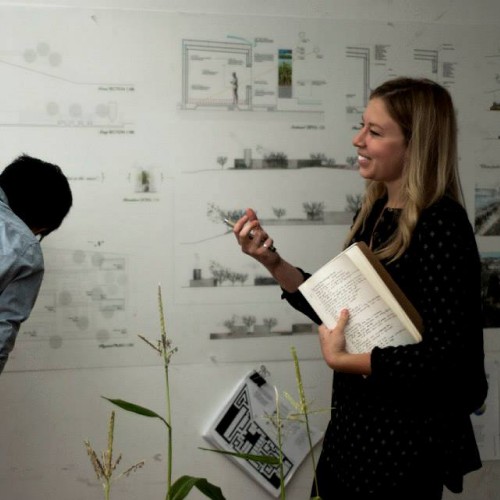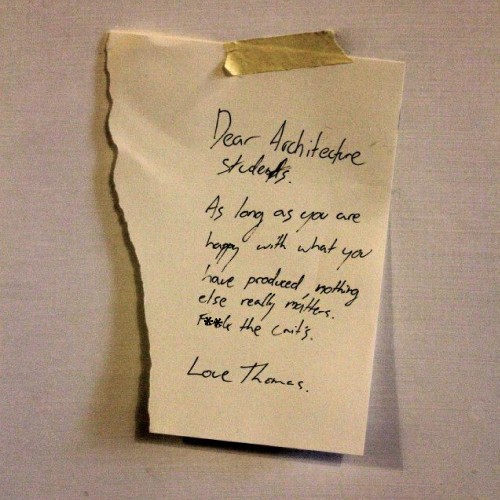To begin, I must use the most valid dictionary, “Wikipedia”, to define the third most used word in architecture school – next to 1. studio, and 2.“the f-word” – critique.
cri·tique [ kriˈtēk ]
noun
1. a method of disciplined, systematic analysis of a written or oral discourse. Critique is commonly understood as fault finding and negative judgement, but it can also involve merit recognition, and in the philosophical tradition it also means a methodical practice of doubt.
Alternatively, the tall-ish, blond-ish girls, who enjoys games of twenty-one and inappropriate banter, state that a critique is a(n) x minute-long, interrupted presentation, with a 2x minute-long cross-examination.
The critique – though an unruly form of torment for the already self-critical architecture student – is one of the most realistic phenomena in the profession. Rem-dawg* would be flippin’ burgers right now, if he didn’t know how to have a successful critique in university (or out).
*Rem Koolhaas.**
**A starchitect.***
***A famous architect.
The following is thus, the scantily tested guide for a successful critique in university (or out):

4A
1. Firstly, you must be passionate. If you are not passionate about your own work, there is a 98.72% chance that no other human will give a(n) “f-word”.
2. You must bring all your rough work to the critique. This can be achieved in either; a neat package held together by a bulldog clip and pinned up with your panels, or a pile of sorts, placed within a 2.5m radius of the critique zone. It is always successful when you reference your methods, process and inspirations.
3. You must introduce yourself – despite what you think, not everyone knows you. Shake hands if you are brave and ask any new faces for their names.
4. You must know your weakness(es), unless you don’t have any. Your weakness(es) must not be emphasized or apologized for during the critique. If the critic is named Sherlock, Nancy or has the last name, Hardy, they might detect your weakness(es). In this case, you must acknowledge your weakness(es) and commend the critic for their detection, then steer the conversation back to your strength(s).
5. You must dress appropriately. Think back to your high school dress code; your bottoms must be longer than your fingertips when they are stretched towards the ground, your undergarments must be under-garments, your navel must remain a mysterious indentation, your garments must not be more than 17% transparent, and no jeggings.
6. You must make your parti/thesis obvious in the first 4 seconds of your critique. Whether your parti/thesis is represented through text, diagram, drawing, model or render, the most obvious way of making things more obvious is by making them bigger – BIG things are obvious.
7. You must entertain the critics like children****. Let them hold and study your maquettes, materials, sketchbooks, and precedents.
[Aside] Imagine sitting and listening to your classmate talk about their project for 30 minutes… ugh yeah, I know! Now multiply that by 10. The jargon tends to get allegorically jumbled, like a conglomeration of rapturous formicidae besieging a glucose substance.You must, must remember that the attention span of an architecture critic – critiquing architecture students – is that of a child****.
****Note: no offence is meant to be taken by these remarks. Children are just shorter, arguably more distracted humans, who like to touch things.
8. When in doubt, you must smile. The exception to this rule is only applicable if you have a scary, pseudo smile that generally makes people uncomfortable.
9. You must not get defensive. Defensive means you’re wrong. You must however, defend.
10. When thinking during a critique, you must take long pauses, and/or sips of water or invisible coffee******. You must also nod, or take notes, or make onomatopoeic gasps and hmmmms – but never all at once.
******Real coffee is hot and procures bad breath.
11. You must be genuine. You are allowed to “not know” or “not have previously considered that idea”. Critics – having been critiqued at one point or another – can smell bullsh*t from 1.61 kilometers away.
12. At the end of your critique, you must say thank-you. Not only is this a great way to avoid the awkward “are they finished?…” moment, but the “Aside” in No. 7 explains why you must be appreciative of the critic’s time.
13. And in the end, despite the achievement of a successful critique in university (or out), you must remember that Thomas is right (refer to the image below).








Leave a Reply